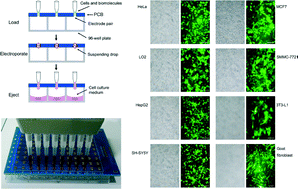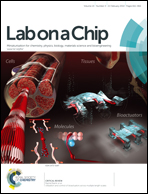An individually addressable suspended-drop electroporation system for high-throughput cell transfection†
Abstract
High-efficiency transfection of genes, proteins, or drug compounds into cells without causing permanent damage is a prerequisite for many cell biology experiments. Here, we report a printed circuit board (PCB)-based electroporation device for high-throughput delivery of exogenous molecules into cells in an individually addressable manner. This device incorporates an array of 96 through-holes on the PCB with a pair of gold coated symmetric electrodes plated on the wall of each through-hole. A mixture of cell suspension and exogenous molecules is top-loaded, electroporated, and bottom-ejected with cell culture medium into the corresponding well of a 96-well plate placed under the PCB. One group of electrodes on the same side of the 96 through-holes were connected to eight top pads via connecting row wires plated on the top surface of the PCB and the other group of electrodes were connected in a column format to twelve bottom pads. Therefore, each pair of electrodes can be selectively energized, guaranteeing that appropriate electroporation parameters can be applied to different holes. We demonstrate the use of the present device to effectively introduce plasmid DNA and synthetic interfering RNA into cultured and primary cells with high cell viability and transfection efficiency. The high performance and low cost features make our device an ideal platform for cellular and molecular research and high-throughput screening.


 Please wait while we load your content...
Please wait while we load your content...